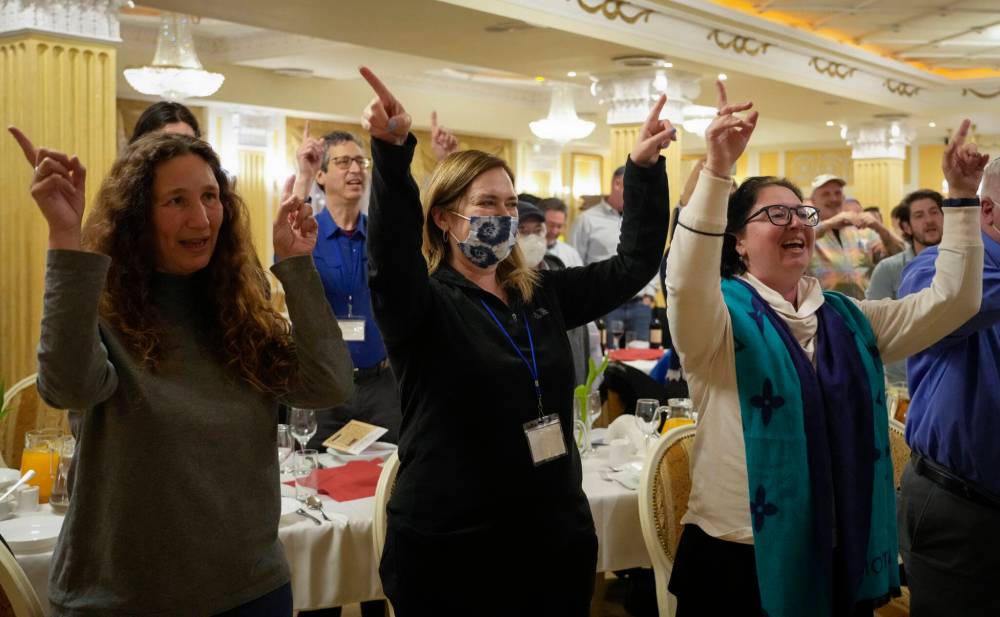Passover and climate change
Jewish people encouraged to add ice blocks to Seder plates, tables
Advertisement
Read this article for free:
or
Already have an account? Log in here »
To continue reading, please subscribe:
Monthly Digital Subscription
$0 for the first 4 weeks*
- Enjoy unlimited reading on winnipegfreepress.com
- Read the E-Edition, our digital replica newspaper
- Access News Break, our award-winning app
- Play interactive puzzles
*No charge for 4 weeks then price increases to the regular rate of $19.00 plus GST every four weeks. Offer available to new and qualified returning subscribers only. Cancel any time.
Monthly Digital Subscription
$4.75/week*
- Enjoy unlimited reading on winnipegfreepress.com
- Read the E-Edition, our digital replica newspaper
- Access News Break, our award-winning app
- Play interactive puzzles
*Billed as $19 plus GST every four weeks. Cancel any time.
To continue reading, please subscribe:
Add Free Press access to your Brandon Sun subscription for only an additional
$1 for the first 4 weeks*
*Your next subscription payment will increase by $1.00 and you will be charged $16.99 plus GST for four weeks. After four weeks, your payment will increase to $23.99 plus GST every four weeks.
Read unlimited articles for free today:
or
Already have an account? Log in here »
Hey there, time traveller!
This article was published 23/04/2022 (1310 days ago), so information in it may no longer be current.
The Passover Seder, the festive meal that marked the start of the eight day Jewish spring festival, is rife with ritual, custom and symbolism. Every object set on the table, every food consumed, and every word read from the Haggadah, the special prayer book used for the holiday, is intended to make every participant feel as though they—not just their ancestors—were liberated from slavery in Egypt.
These items typically include matzah, or the unleavened bread of affliction, saltwater representing the tears of the slaves, a cup for the prophet Elijah, and the Seder plate, which is the centerpiece of the Seder table.
Seder plates, whether they are fragile family heirlooms passed down from one generation to the next or floppy construction paper creations glued together at Hebrew School, traditionally display five foods, each one of them symbolizing a different aspect of the Exodus narrative. There is the shank bone representing the sacrifices made in ancient times; the egg representing wholeness; the apple mixture charoset, symbolizing the mortar used to make bricks; the green vegetable symbolizing spring; and the bitter herb representing the anguish of slavery.

In modern times it has become common practice in many households to add other non-traditional items to the plate to represent or remind Seder participants about other social justice or timely issues. These include oranges to represent the ongoing struggle for women’s equality, olives to represent the ongoing quest for peace in the Middle East, and acorns to represent the ongoing need for Indigenous land acknowledgements.
For this year’s Seders, which took place last weekend, the Jewish Climate Network encouraged Jewish people around the world to add ice blocks to their Seder plates or tables. The ice blocks, of any size or shape, were intended to represent the melting ice caps and the significant global threat from climate change brought on by human activity and indifference.
“At the Jewish Climate Network, we understand that we have to change the way we consume and create energy at every level,” explains Elinor Hasenfratz, the Australian-based organization’s programs and communications coordinator.
“Motivated by this urgency,” she continues, “we encouraged (Seder hosts) to place a block of ice on the Seder table to prompt a discussion about climate change, climate solutions and where we as Jews, individuals and as a community, fit into this complex issue.”
“If there was ever a time for Jewish people to get together and discuss the big issues,” she adds, “it’s at the Seder table on Pesach.”
It is certainly easy enough to link the current environmental crisis to the basic themes and images of a religious holiday that celebrates redemption, renewal and gratitude. The fact that Earth Day, this year, occurred during the Passover holiday makes that association even more explicit.
“As Jews who value life and existence and respect creation, it’s the ultimate disrespect to destroy the planet,” says Sabrina Malach, the director of community engagement for Shoresh, the Jewish environmental organization that promoted the ice block idea in Canada. “The Torah commands us not to destroy the world and climate change poses a very real threat of that happening,” she adds.
Placing a frozen ice block in the middle of the Seder table and watching it slowly melt, of course, did nothing to mitigate that threat, but it would have at least sparked conversation about what might be done. Perhaps more importantly, it also reminded those gathered at the table in celebration of an ancient event that the future should matter as much as the past.
swchisvin@gmail.com
The Free Press is committed to covering faith in Manitoba. If you appreciate that coverage, help us do more! Your contribution of $10, $25 or more will allow us to deepen our reporting about faith in the province. Thanks! BECOME A FAITH JOURNALISM SUPPORTER
The Free Press acknowledges the financial support it receives from members of the city’s faith community, which makes our coverage of religion possible.


